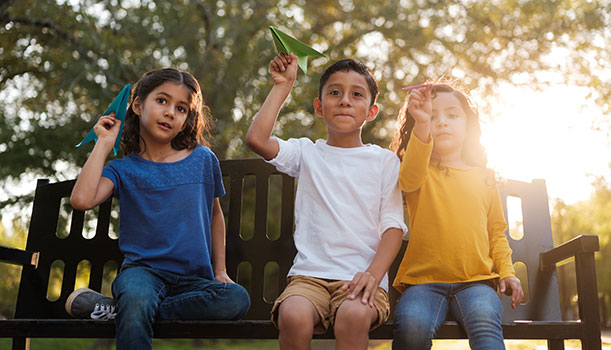BOOMbox at Home: Physics Activities
August 6, 2020

This week we’re launching things into the air and seeing how far they go, all in the name of physics experimentation.
Flinging Things
Imagine that you’re leading a medieval army and you need to storm a castle to save your country, but the castle is protected by a strong stone wall. How would you knock down the wall without modern technology to help you?
The medieval answer to this challenge was the catapult--a simple machine that allowed ordinary humans to throw heavy things like big rocks and cannonballs across long distances. Most catapults work by using a lever to reduce the amount of effort needed to lift the heavy object.
Try building your own catapult using some Popsicle sticks and rubber bands. Remember to be safe! Don’t put anything sharp or too heavy into the catapult and don’t point it at people or pets or windows. If you can, make sure to position the catapult so that projectiles, which are things thrown from a machine, land on a wide, soft surface like your bed, or a big empty patch of carpet or grass.
As you work on your catapult, think about these questions:
- Apart from making catapults, what else can you use a lever for?
- What happens if you make the arm of your catapult longer?
- What happens when you put objects of different weights into the catapult?
One way to make your catapult more effective is to use a heavy weight at one end to balance the weight of the projectile. Now your catapult has turned into a trebuchet. You can add a pencil, a straw, and some glue to make a trebuchet, watch a trebuchet tutorial from Mythbusters, or read about trebuchet design.
If you don’t have any building materials, you can still experiment with catapults by playing games like Angry Birds.
Flying Things
Paper (like most things) is heavier than air, so how do we get planes to stay in the air for a long time before gravity drags them down? A flat sheet of paper might float down slowly like a parachute because its large surface area creates air resistance, but it can’t travel through the air because its shape is not aerodynamic (which means that it does easily not move through air).
Folding the paper to make an airplane makes it travel through the air more easily because the wings provide lift, preventing it from falling quickly, while the pointy nose reduces drag, making it more aerodynamic.
Follow paper airplane design instructions to fold different types of paper planes to see which shape makes the plane travel faster and which shape helps the plane stay up in the air longer.
You can also build a record breaking paper plane. This design was created by John Collins, “the paper airplane guy,” who holds the world’s record for the length of a paper airplane’s flight. You can watch his instructions on how to fold a record-breaking plane, or a fold a paper plane that comes back to you, like a boomerang. On his TED Talk he describes how he experiments to make his planes better.
The way a paper airplane is shaped changes the way it will fly, and the same is true for real planes. You can see which planes go faster or do tighter turns using the GeoFS flight simulator.
Landing Safely
Now that you’ve launched the plane into the air, you’ll need to find a way to get your pilot back down to earth safely.
Can you use what you’ve learned about aerodynamics to help your pilot land safely? The contraption will need to help the pilot slow down before the plane hits the ground. If you’re stuck, you can follow NASA’s instructions for how to make a moon lander.
You can also learn by watching this video on preparing for landing, and by helping the Curiosity Rover land safely on Mars with this landing simulator.
Scientist of the Week
Dr. Hadiyah-Nicole Green is the 76th Black woman to receive a Ph.D. in physics from an American university, according to African American Women in Physics. She has successfully combined lasers and nanotechnology to eliminate cancer in mice after one 10-minute treatment. Her research now is focused on applying that technology to human patients.
Dr. Green is also very active in mentoring students. “Black girls don’t see (scientist) role models as often as they see Beyoncé or Nicki Minaj,” says Green. “It’s important to know that our brains are capable of more.”
Share
We’d love to see the results of your experiments! Tag @skokielibrary when you share photos of what you’ve created on social media.
Written by Michelle and Pam.